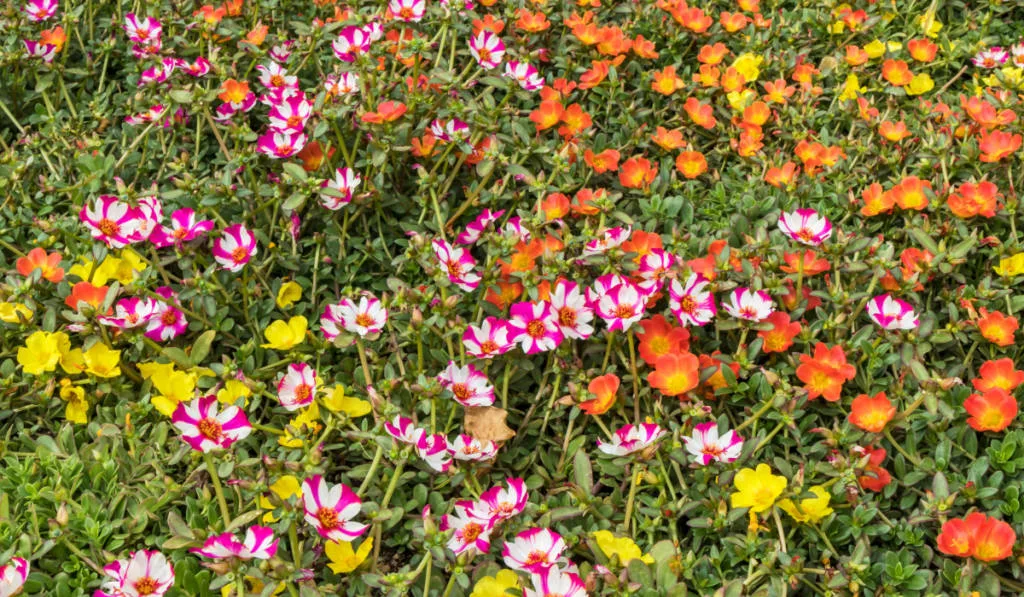Nobody enjoys spending all of their outdoor time during the growing seasons weeding their gardens and lawns. Many gardeners learn how to eliminate and keep away weeds from their gardens with little or no effort by planting ground cover.
Does ground cover prevent weeds?
Ground covers prevent weeds by blocking direct sunlight from the soil surface and competing for nutrients and water. Thick ground covers inhibit seed germination and suppress weeds. But thin ones cannot intercept direct sunlight with the same efficiency.

Keep reading as we discuss three facts about ground covers and ten of the best weed-suppressing ground covers. We will also take you through the installation process for ground covers.
Table of Contents
Do Weeds Grow Through Ground Cover?
Established ground covers provide a shield that keeps direct sunlight off the soil surface. As a result, weed seeds don’t germinate. Ground covers are also adapted to survive in extreme climatic conditions and compete for nutrients and water, thus suppressing any existing weeds.
However, thin ground covers do not fully shield the soil surface from direct sunlight, and some weeds might still grow through.

What Ground Cover Will Stop Weeds?
A ground cover that grows fast and thick enough to cover the soil surface and can competitively fight for nutrients and water in the soil will stop weeds. Moreover, an ideal weed-suppressing ground cover should be long-lasting but not invasive.
What Is the Point of a Ground Cover?
Ground covers are beneficial to your lawn or garden for several reasons. Some of their benefits include:
- They control weeds, saving you weeding labor and herbicides.
- Ground covers add beauty and variety to your garden and a smooth transition between the lawn and taller plants.
- They can grow in extremely dry or wet areas.
- They minimize or eliminate mowing requirements as they are low growing.
- They stabilize slopes by preventing soil erosion.
- They can thrive in shady areas such as under trees where grass can’t grow.

How Do You Install Ground Covers to Prevent Weeds?
Before installing your ground cover, you require proper planning and timing for your plants to grow well.
For instance, it is best to plant in early summer or spring so they may root well and not heave out during winter.
Here are the steps to install your ground cover to prevent weeds:
- Assess your site conditions.
- Prepare the soil.
- Start planting.
- Maintain your plants.
1. Assess Your Site Conditions
The first step in setting up a ground cover is to evaluate your soil and site. Check your soil type, texture, and acidity level. And find out if you need to add gravel or organic matter.
Also, study the shade and sun patterns and whether the site has any protection against winter winds. Once you have information about your garden, you can select the best suitable plants.
2. Soil Preparation
Before planting, you should eliminate as many weeds as possible. Apply weed control herbicides to kill any vegetation present. Alternatively, you can dig out the weeds by hand, which is more effective.
Then, use a rake to turn in a 3-inch leaf mold or composted manure layer. Also, this is the right time to add any modification to the soil, such as sulfur or lime.
3. Start Planting

Once your site is ready, lay the plants in your desired pattern. How fast the plants cover the ground depends on the plants’ size, growth habits, and how you space them. The closer you plant them, the sooner they will fill the garden and relieve you of the task of weeding.
4. Maintain Your Plants
After planting, apply a 2-inch mulch layer to help preserve moisture and keep off weeds. The first few years will require diligence and effort. You should monitor, weed, and water the plants to ensure they grow well and form a solid cover.
10 Best Ground Covers for Preventing Weeds
The best ground cover for your garden depends on your location and soil type. Some ground covers grow well in areas with moist soil, while others thrive in well-drained or dry soil.
It’s best to know your climatic zone first, then consult a nursery and discuss particular plants before buying. You can use the USDA Plant Hardiness Zone Map to find your zoning.
Here are ten of the best ground covers for preventing weeds.
| Name | Light requirement | Characteristics | Suitable Conditions |
| Ajuga ‘Burgundy Glow’ | full shade | Ajuga creeps over the soil surface, extending roots down along the way. Its leaves knit together, leaving no space for weeds to wheedle. Moreover, they have vibrant purple and green foliage and white edging, forming a perfect colorful cover. | They grow well in humusy moist soils with good drainage. |
| Aubrieta ‘Red Cascade’ | Full sun | They are beautiful, versatile, and hardier. Spreads by forming colorful clumps and suppresses many weeds. | They thrive even on the poorest soil types. |
| Wild Strawberry | Full sun | Wild strawberries are a perfect choice for bird watchers; they attract wildlife to eat the sweet fruits. Also, they are edible, and you can harvest them. Once they take root, they spread quickly through underground runners choking out weeds. | Wild strawberries thrive in well-drained loamy soils. |
| Moss | Part shade | Moss is low-growing and spreads quickly, forming a plush, thick green carpet that blocks light and prevents weeds from growing. | Moss grows well in moist soils with low pH. They are suitable under trees and rock ledges. |
| Gypsophila ‘Prostrata Pink’ | Part shade | They have silvery-green, mounded foliage with plenty of dainty pink flowers during summer and suppress pesky weeds. | They can grow in dry stone walls and rockeries. |
| Sedum spurium | Part shade | Sedum spurium spreads through trailing stems that easily root and is among the most versatile and hardiest weed-suppressing ground covers. Also, they have fleshy bright green leaves with pink star-shaped flowers. | They grow well in most conditions. |
| Campanula glomerata ‘Superba’ | Full sun to part shade. | Campanula is stable and reliable and has long-spreading colorful foliage. They also have large, bell-shaped, vivid blue flowers that add lasting beauty to your garden all summer. | They thrive in moist and well-drained soil. |
| Phlox subulata ‘Candy Stripe’ | Full sun | Phlox is one of the best perennial creeping ground covers. They are drought-tolerant and work well against weeds. | Phlox grows well in any soil type. |
| Rose of Sharon Hypericum calycinum | Full sun to part shade. | They have star-shaped yellow flowers that are very attractive to bees. Also, they are low-growing and shrubby and are among the best weed-preventing ground covers. | They thrive in moist and well-drained soil and are best for northern climates. |
| Thymus serpyllum | Full sun | Thymus is drought and heat tolerant and a great option in fighting weeds. | Great for planting in crevices. |
Ground covers are the best solution to lawn and garden weeds if you select the right plants for your site and take care of them. It might take you a couple more years of weeding, but the hard work will eventually pay off. Once the plants grow and form a dense cover, you won’t have to worry about weeds anymore.
Resources
- https://extension.colostate.edu/topic-areas/yard-garden/ground-cover-plants-7-400/
- https://planthardiness.ars.usda.gov/
- https://extension.umd.edu/resource/groundcovers
- https://mro.massey.ac.nz/handle/10179/4102
- https://www.maine.gov/dacf/php/gotpests/weeds/factsheets/weed-supp-gc-cornell.pdf
- https://www.hopesgrovenurseries.co.uk/shop/ground-cover/hypericum-ground-cover/
